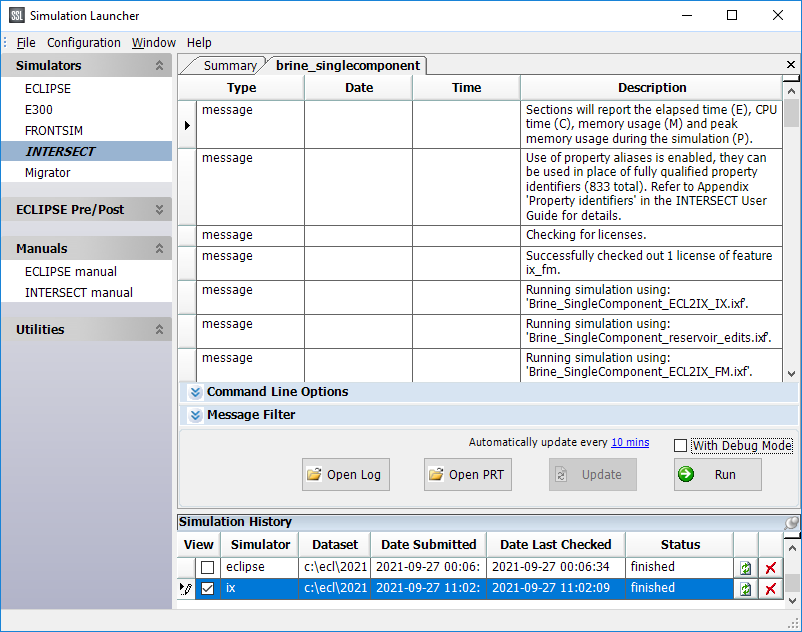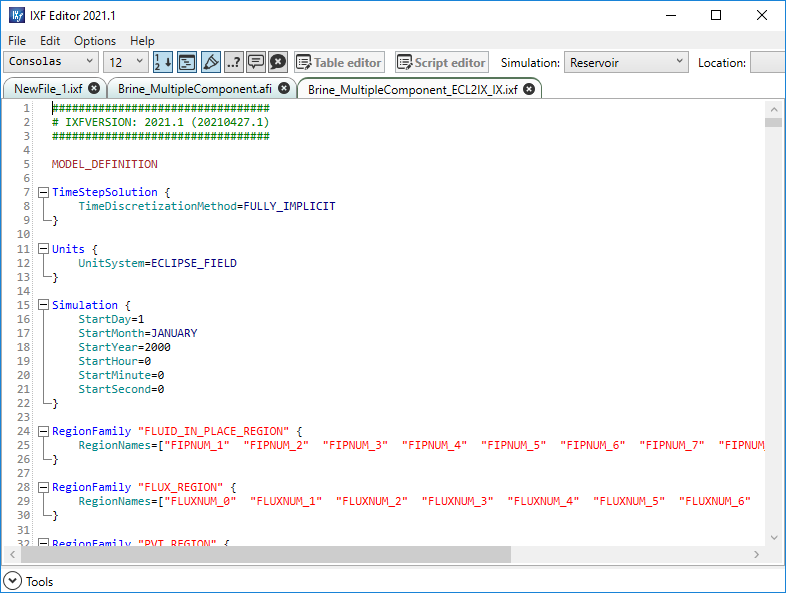شبیه سازی مخزن با وضوح بالا | Intersect 2021.1

The INTERSECT high-resolution reservoir simulator is the answer to many of your reservoir challenges. Operators can simulate detailed geological features and quantify uncertainties, by creating accurate production scenarios and, with the integration of precise models of the surface facilities and field operations, the INTERSECT simulator produces reliable results which are constantly updated by real-time data exchanges.

The release of INTERSECT 2021.1 delivers many key features in innovation, field management, usability, physics and fidelity. These features include the first commercial release of machine learning in the simulator, enhanced ways to interact and utilize Field Management expressions, new fluid stream modeling controls, improvements to IX-ENS coupling and extended physics for heavy oil and coal. Usability continues to be a key focus, with the first release of a Field Management template, simple aliases for property identifiers, and more. Additional ECLIPSE keyword support is given to the migrator, with focus on surface equation of state keywords.
Release updates for 2021.1
Innovation
Machine Learning in INTERSECT: A machine learning (ML) framework is implemented in INTERSECT with TensorFlow. The framework allows the introduction of data-based intelligence into reservoir simulation, such as new physics and fast computation in the form of neural networks, enabling many use cases. INTERSECT 2021.1 introduces the commercial release of the feature first present in 2020.4. This functionality is able to estimate the critical temperature used in phase labeling for compositional mixtures using neural networks.
Field Management
Field Management template for economic control actions: a new EconomicLogicTemplate node has been introduced that allows modeling of economic control actions on different flow entity types, based on conditional evaluation, using a compact and stable mechanism. This template internally expands to normal IXF schema.
Functions in Field Management expressions: new functions (Natural logarithm, Absolute value, Exponential) have been introduced in this release, that can be utilized as part of the existing expression framework. Additionally, MaxFunc/MinFunc have been extended to support additional arguments to allow clipping to a constant (minimum/maximum) value. Another extension is provided through MinFunc0/MaxFunc0 that enables evaluation using the provided entity, instead of the sub-ordinate entity.
Component removal in fluid streams: a new node MaxComponentSourceMoleFractions has been added to enable the removal of specific components in fluid streams to mimic process operations such as gas stripping. For example, the sales gas may be required to exclude CO2, a fuel stream may be required to have a limited amount of N2, and reinjection gas may be required to exclude any H2S – These operations can now be modeled using this new functionality.
Real property data types with Expression: a numerical expression can now be used in all fields that require a Real Property data type (e.g. FluidStream.TargetRates). This allows the Real Property value to change dynamically under certain conditions. This new development can be used to model dynamic changes using the expression framework.
Improvements for IX-ENS coupled models: The IX-ENS network coupling feature has been extended with a user option to control whether the IPR table passed into an ECLIPSE Network Solver (ENS) model contains time-averaged (considering UptimeFraction) or peak (not considering UptimeFraction) well rates.
Exponents in mixture density and viscosity for flow control devices: the FlowControlDeviceDef node now supports exponents that are used for calculating the mixture density and viscosity at local conditions, which then forms part of the pressure loss calculation for the device. It is also supported by the migration of the WSEGAICD keyword.

Physics
New viscosity mixing rule for solvent: new options allowing to customize weighting factors that multiply component viscosity tables in order to calculate mixture oil phase viscosity have been added under the ViscosityMixingRule node.
Pressure and temperature dependent component molar enthalpy: a new node, EnthalpyTemperatureTable, has been added to enable phase enthalpy calculation in thermal simulations. This feature is important for modeling solvent injection cases at superheat conditions or for CO2 injection where phase enthalpies vary with pressure and temperature.
Non-monotonic rock compressibility tables: on the CompactionMultiplierTable node, one can now specify decreasing pore volume and/or transmissibility multiplier values. This enables the approximation of Palmer-Mansoori type models for coal formations where, due to desorption, this type of relationship between multipliers and pressure may be observed.
Usability
Field Management default strategy: An automatic strategy usability feature has been introduced. The UseAutomaticStrategy field in FieldManagement node provides the capability of encapsulating all defined Instructions in an auto-created strategy, thus the user not needing to explicitly add the Instructions to a strategy.
Paired Surface Fluid model: a new field PairedSurfaceFluidModel has been introduced in the CompositionalFluidModel node to allow pairing between reservoir fluid models and surface fluid models, that is utilized in dynamic assignment of WellBoreFluidModel and SurfaceFluidModel for wells. This feature is mainly utilized for workflows using surface equation of state.
Property identifier aliases: for brevity, you can now use short aliases in place of the property identifiers in the input schema (except in custom scripts). For example, BHP can now be used instead of BOTTOM_HOLE_PRESSURE wherever that is used as a property identifier. These aliases, where available, are listed in Appendix A.1 Property identifiers in the INTERSECT User Guide.
Report PI multiplier and skin in summary file: two new properties (PI_MULTIPLIER) and (SKIN_FACTOR) have been added to the relevant nodes for summary vector reporting. These properties can be reported at Well Completion and connection level and are especially useful when using the WellPIControl or manual PI and/or skin overrides in simulation.
Additional Editable properties: Several additional properties (e.g. FLOAT_WORK_ARRAY, etc.) have been added to the list of editable properties allowed in BoxPropertyEdit and CellPropertyEdit.
Migrator:
ECLIPSE simulator keywords for surface equation of state are supported by the migrator in this release: EOSS, TCRITS, PCRITS, VCRITS, ZCRITS, BICS, MWS, ACFS, OMEGAAS, OMEGABS, SSHIFTS, ZFACTORS, TREFS, DREFS, PREFS, KVCRS, CVTYPES.
GRUPTARG with item 2 set as GUID can now be migrated.
Cell ranges are supported for migration from COMPDAT, COMPDATL, COMPLUMP and COMPLMPL.
Key benefits using INTERSECT:
High-resolution modeling for complex geological structures
Completion configurations for complex wells.
Detailed chemical-enhanced-oil-recovery (EOR) formulations
Application of steam injection and other thermal EOR methods.
Advanced production controls in terms of reservoir coupling and flexible field management
Flexibility to script customized solutions for better modeling and field management control.
Leverage the full potential of the INTERSECT simulator using the DELFI cognitive E&P environment to rapidly simulate multiple concurrent cases using DELFI On Demand Reservoir Simulation.
Better simulations: Closing the gap with seamless geomodelling to simulation solutions
The INTERSECT simulator provides outstanding performance in advanced geomodelling to simulation workflows that enable reservoir engineers to produce comprehensive views of the reservoir behavior. Understand and quantify the geological risk and make the best decisions to ensure profitability of your projects.
Everybody’s in: Real integration from reservoir to processing
Using INTERSECT Field Management, you can recreate close-to-operations controls of even the most complex fields, for accurately predicting and generating behavior. The module is accessed through IAM (Integrated Asset Modeling), which provides an advanced framework to couple the INTERSECT simulator to networks, facilities, and processing simulation tools.
The INTERSECT simulator and Python: A powerful combination
The Python scripting capabilities in INTERSECT 2020 are significant more advanced than in the previous version, increasing users’ abilities to solve project-specific challenges by developing custom-made scripts.
Keep it real: The INTERSECT simulator and Depogrid produce reliable result
Depogrid enables geologists and geomodelers to capture all the different unconformities and changes on the structure of the reservoir with high levels of detail. The unstructured nature of the gridding Depogrid models are simulated by the INTERSECT simulator to capture the effects on fluid flow.
Find the best well completion: Optimize well completion configurations in one run
The INTERSECT simulator uses advanced completion optimization (ACO) to ensure the flow control valve (FCV) configuration is always operating at its optimum point. Instead of running different cases with different configurations, different parameters of the FCV are optimized by report step, ensuring specific configuration produces the production performance.
Ensure the best sweep efficiency: Pattern flood management to improve injection efficiency
The INTERSECT simulator generates streamlines as simulation runs to solve the various problems you face relating to reservoir connectivity. In INTERSECT 2020, this capability has been extended to several applications and one of them is pattern flood management, which used the power of the streamlines the INTERSECT simulator generates to determine the optimum contribution of each of the injector wells and how that is translated into higher sweep efficiency.
تیم PetroTools آخرین نسخه این نرم افزار را برای شما ارائه می دهد. جهت تهیه نرم افزار با استفاده از منوی خرید با ما در تماس باشید
For buy software, Please contact us via buy menu



 O-Sense
O-Sense
